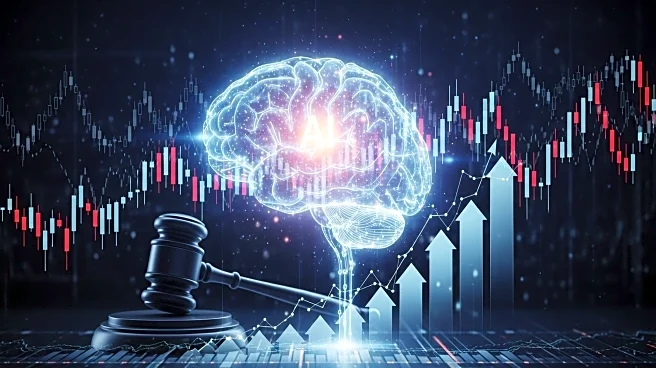What's Happening?
The U.S. labor market experienced a significant slowdown in August 2025, with only 22,000 jobs added, far below the expected 75,000. This has led to a rise in unemployment to 4.3%, the highest since 2021. As a result, there is now a 100% probability of a 25-basis-point rate cut at the upcoming Federal Open Market Committee (FOMC) meeting. The Federal Reserve's focus has shifted from inflation to employment, as indicated by the CME Group's FedWatch tool, which shows a 12% chance of a 50-basis-point cut. This shift has led to a surge in equities, with the S&P 500 and Nasdaq reaching record highs. The 10-year Treasury yield has fallen to 4.07%, reflecting expectations of cheaper capital and accommodative monetary policy.
Why It's Important?
The anticipated rate cuts are expected to benefit AI-driven sectors and high-growth tech stocks, which thrive on low borrowing costs. AI-related capital expenditures by major companies like Microsoft and Amazon have significantly contributed to GDP growth. Stocks in the semiconductor and cloud infrastructure sectors, such as NVIDIA and AMD, have seen substantial gains. However, analysts warn of potential overvaluation in AI stocks, suggesting that investors should wait for concrete earnings growth before making significant commitments. Diversification strategies, such as equal-weighted ETFs, can help mitigate exposure to a potential AI-driven bubble.
What's Next?
As the Federal Reserve prepares for potential rate cuts in September, and possibly in October and December, investors are advised to focus on AI, semiconductors, and cloud infrastructure while hedging against sector-specific risks. The synchronized global fiscal push and AI's transformative potential suggest that the current reflationary cycle could extend into 2026, offering opportunities for strategic capital deployment.
Beyond the Headlines
The weak jobs data and subsequent rate cut expectations highlight the delicate balance the Federal Reserve must maintain between inflation and employment. The focus on AI-driven sectors underscores the growing importance of technology in economic growth. However, the potential overvaluation of AI stocks raises concerns about a possible bubble, emphasizing the need for careful investment strategies.













